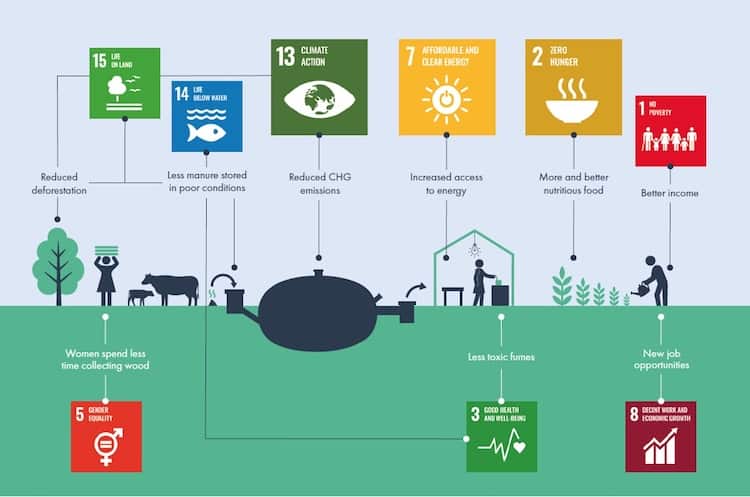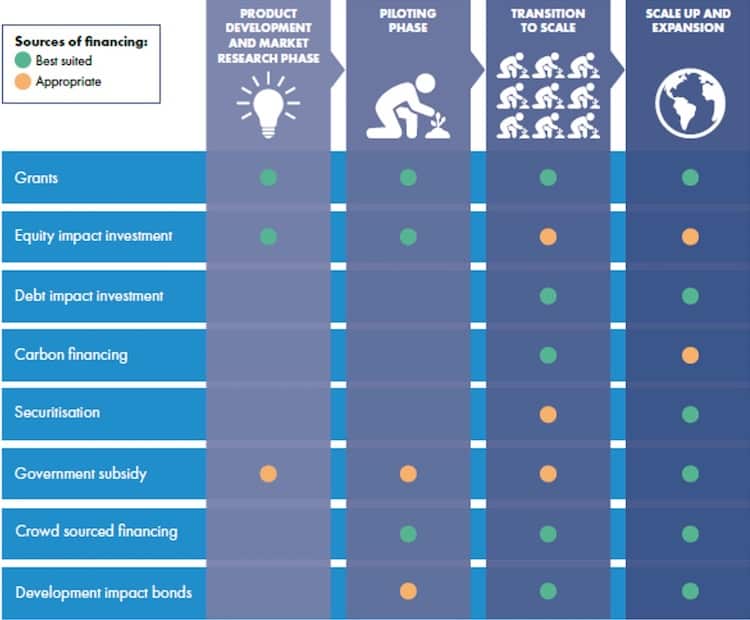Scaling Biodigesters: How Appropriate Financing Can Help This Undervalued Technology Deliver Social and Environmental Impact
Biodigesters are not a new technology. They’ve been used in various forms for centuries, to break down organic material like food scraps, animal and human waste to produce biogas, a renewable energy source that can be used for cooking and heating, as well as bio-slurry, which can be used as fertiliser. Yet their spread has been slow. In Africa alone, there are 32.9 million agricultural households that could adopt biodigesters — i.e., they meet the two basic requirements to run them: sufficient availability of both dung (at least three cattle) and water. But market penetration is less than 1% of that. For impact-orientated investors, bilateral and multilateral donors, and individuals and companies seeking to offset their carbon emissions, this untapped market represents a huge opportunity to generate social and environmental impact while making a financial return.
Shell Foundation is a U.K. charity dedicated to alleviating poverty by supporting energy access business solutions in Africa and Asia. We wanted to explore the impact of biodigesters as linked to the Sustainable Development Goals (SDGs) and highlight the financing the sector needs to scale. So we commissioned an impact study with IPE Triple Line, “Demonstrating the Potential of Biogas to Contribute to the SDGs,” developed in close partnership with Sistema.bio, as part of our agriculture partnership with the U.K.’s Foreign, Commonwealth and Development Office. Below, we discuss the study’s findings and explore the impact biodigesters can make, while identifying the kinds of financing required to support growth in the market.
Biodigesters’ contribution to the SDGs
The benefits that biodigesters generate contribute to many SDGs, as shown in figure 1 below. However, there are particularly strong links with SDG 2 (Zero Hunger), SDG 7 (Affordable and Clean Energy) and SDG 13 (Climate Action).

Figure 1. Adapted from Africa Biogas Partnership Program (ABPP), C. 2017, Yoram Cok
SDG 2: Zero Hunger: As mentioned above, the chemical reaction that produces biogas within a biodigester generates a by-product, bio-slurry, which is an effective organic fertiliser. When treated with bio-slurry, crops tend to have higher levels of nutrients and protein than with other types of organic fertilisers. This can lead to the production of more nutritious food for farmers and their communities, reducing rates of malnutrition.
Bio-slurry can also significantly improve agricultural yields, particularly for poor smallholder farmers with limited access to fertiliser. In Kenya, 94% of Sistema.bio’s farmers reported an increase in yields after using bio-slurry. The impact can be substantial; for maize, a common food staple, bio-slurry can increase yields by nearly 40%. This helps reduce food insecurity by increasing available food supplies and boosting the incomes of smallholder farmers.
SDG 7: Affordable and Clean Energy: Worldwide, nearly 3 billion people still rely on wood, charcoal and coal for cooking. These fuel sources are non-sustainable and inefficient, and they release dangerous particles. In contrast, biogas is sustainable and more efficient, and it is a clean fuel that does not emit harmful particles into the air. After the initial purchase of the biodigester, the biogas generated is also free. This can generate significant cost savings for poor smallholder farmers, as the average Sistema.bio customer was spending over $300 a year on energy before buying a biodigester. The exact amount of cost savings for customers varies by geography and prior energy use-cases, but it is substantial. For example, studies conducted in Ethiopia and Uganda estimated the annual cost savings after biogas adoption as $328 and $289, respectively.
SDG 13: Climate Action: Biodigesters can contribute to the reduction of greenhouse gas (GHG) emissions through several mechanisms. By capturing methane emitted by manure and converting it into CO2, biodigesters help to mitigate a major source of GHG emissions. Access to bio-slurry as an alternative to chemical fertilisers can also reduce demand for those fertilisers, which are significant contributors to GHG emissions. Finally, biogas also replaces GHG-emitting energy sources, such as wood and charcoal. Reducing reliance on wood and charcoal for cooking can reduce deforestation, which accelerates climate change. Estimates suggest that a biodigester can save 55 to 220 tonnes of CO2e over the course of its lifespan.
Financing costs for biodigesters — what is needed from whom?
However, to achieve these benefits at a meaningful level, biodigesters need to be adopted at a much greater scale — and that will require a new approach to financing this technology. To reach low-income households, biodigesters need to be sold on credit, enabling consumers to spread out the up-front cost. This means that biodigester companies require significant working capital financing to support this core component of the business model.
In addition, these companies need longer-term investment capital to build up the production capacity for biodigesters and to set up last-mile distribution and maintenance networks that reach rural communities. As a result, biodigester distributors seeking to scale require a range of different types of financial support. And because revenues are largely based on predictable cash flows from customer repayments, the business model is well-suited to both debt and equity financing.
The type of financing biodigester distributors need to support their growth varies depending on their different stages of maturity. That means there is a role for multiple types of financial supporters, with varying risk appetites and different expectations around financial returns. To help identify the right way to support biodigesters, the report maps different financial instruments to the four critical stages of growth for biodigester distributors (see figure 2 below). This provides a framework for biodigester companies to understand what financial instrument they should be aiming for given their level of development, while also guiding investors, donors and governments on where they are best placed to provide support.

Figure 2: Adapted from the report ‘Demonstrating the potential of biogas to contribute to the SDGs’, 2020, IPE Triple Line
Non-Financial forms of support
Besides providing financial support, there is a range of other options for organisations seeking to support growth in the biodigester market.
For instance, while there is a clear body of evidence for the significant impact of biodigesters, there are still gaps in some areas. Most notably, there is limited research on the link between the growth of the biodigester market and reducing rates of deforestation. These gaps represent a key opportunity for research organisations.
For NGOs, official development assistance programmes and other organisations working with smallholder farmers, there are also clear support roles available. For example, they could help to raise awareness about the benefits of biodigesters, and educate and sensitise communities about the health risks of cooking using traditional wood and charcoal energy sources.
For more information about these opportunities, a detailed review of different financing mechanisms for supporting biodigesters, and an overview of why and how the technology is so impactful, read the full report: “Demonstrating the Potential of Biogas to Contribute to the SDGs.”
Tanya Kothari is an Agriculture Research and Advocacy Manager for the CASEE programme, a partnership between the Shell Foundation and the U.K. Foreign, Commonwealth & Development Office.
Photo courtesy of AIDG.
- Categories
- Agriculture, Energy



